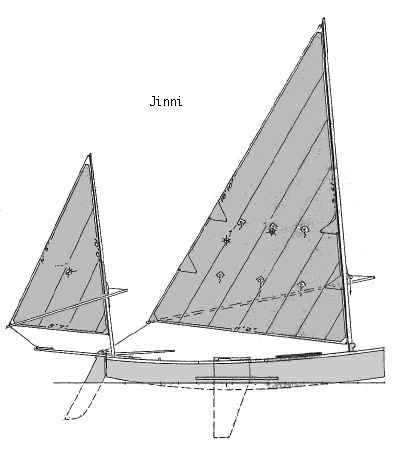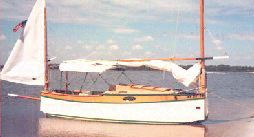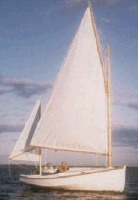![]() Back
to the Boats or to The
Cheap Page or to Michalak's
Boats
Back
to the Boats or to The
Cheap Page or to Michalak's
Boats
 Phil
Phil Bolger
Bolger Books,
Books, Boats
Boats &
& Magazine
Articles
Magazine
Articles
 Some
Bolger Boats
Some
Bolger Boats Build
the Pirogue 12 (Instructions, sorta, and
plans)
Build
the Pirogue 12 (Instructions, sorta, and
plans) Some
Magazine Articles
Some
Magazine Articles The
Bolger
Boat Honor Roll (People who've built
Bolger boats from 6ft on up).
The
Bolger
Boat Honor Roll (People who've built
Bolger boats from 6ft on up).
![]() Tim
Fatchen's Bolgerama-Down-Under: Tres Amusant
Tim
Fatchen's Bolgerama-Down-Under: Tres Amusant
- Light Schooner Home Page: Tons of Bolger Boat Links; great photo links;
- and Tim's Square Boats too. AS19-29-39 and whatnot by Bolger.
![]() Bill
Samson's Newsletter Chebacco
News: Almost 30 issues!
Bill
Samson's Newsletter Chebacco
News: Almost 30 issues!
![]() Joe
McWilliams' Shantyboats:
some Bolger, some Michalak, some Atkin...
Joe
McWilliams' Shantyboats:
some Bolger, some Michalak, some Atkin...
![]() and
Dynamite Payson's Instant
Boats page. The muthalode of small
Bolger Boats.
and
Dynamite Payson's Instant
Boats page. The muthalode of small
Bolger Boats.
- Charles Andrews says:
- I've read a number of Bolger's books, and I've been a devoted follower of his work for the last 10 years. I even commissioned a design: look for the wild brigantine in Boats With an Open Mind, the section on *Period Pieces,* that's the one. I've built the Scooner, which I still have. I cruised Black Skimmer and I have an unfinished Elegant Punt in my basement.
Anyway... I really think Phil can realistically be grouped with the greatest yacht designers of this, or any century: he's right there with the Herreshoffs, father and son, the Atkins, Garden, Peterson, Stevens...but with a difference. Phil is the only one of the bunch (other than, provisionally, John Atkin) who designs great vessels for amateurs to build cheap. Boat after boat of his shows his encyclopedic erudition and creativity in the area of boat design; and he's nearly always ready to point out areas where he hasn't quite thought something through, which may make him unique among designers. His books on boats are, quite simply, a gold mine of information, probably not duplicated by anyone, other than perhaps William Garden; and even Garden doesn't reveal his creative process to the extent Phil does.
- Links take you to a table of contents & comments for each book:
- Small
Boats
- Bolger's original cache of "Instant Boat" ideas.
- The
Folding Schooner...
- More mad schemes...
- Different
Boats
- Hard-to-find, but worth it.
- 30-Odd
Boats
- About thirty, and not really so odd.
- 100 Small Boat Rigs
- This is a great book. Bolger goes over just about
every rig you can imagine, including some which you
probably haven't, with a cartoon-sketch accompanying
each.
Out of print but a few copies may be lurking around from Boatbuilder Books for $19.95. Include $3 shipping in the USA, $6 Canada, $12 elsewhere.- Fax: 407-459-1558/Vox: 407-459-3636
- Box 540638, Merritt Island FL 32954
- This is a great book. Bolger goes over just about
every rig you can imagine, including some which you
probably haven't, with a cartoon-sketch accompanying
each.
- 103 Small Boat Rigs
- Republished by Phil Bolger & Friends, the
three new rigs come in an essay on the merits of the
Chinese Gaffer. It may sound odd, but the CG is well
reasoned and has antecedents in the rigs of Commodore
Munroe's sharpies and in an obscure 1939 book by
circumnavigator Conor O'Brien called Sea-boats,
Sails and Oars.
- Republished by Phil Bolger & Friends, the
three new rigs come in an essay on the merits of the
Chinese Gaffer. It may sound odd, but the CG is well
reasoned and has antecedents in the rigs of Commodore
Munroe's sharpies and in an obscure 1939 book by
circumnavigator Conor O'Brien called Sea-boats,
Sails and Oars.
- Bolger
Boats
- A reprint of Small Boats and The Folding Schooner...
- Boats
With An Open Mind
- The only collection of designs currently in print, and well worth it. Includes many classics: AS29, Martha Jane, Micro, and more.
![]() Bolger-Related
Books - titles by Dynamite Payson you're likely to
see referred to again and again.
Bolger-Related
Books - titles by Dynamite Payson you're likely to
see referred to again and again.
- Payson's Instant Boats web page. Plans and information.
- Instant Boats
- Nail and glue designs. External chines for simple building.
- Build the New Instant Boats
- "Tack-and-tape" designs
- Build the Instant Catboat
- Build BOBCAT, a 12-ft catboat.
- Build the Gloucester Light Dory
- Messing About in Boats (cartoons 1995-1999)
- WoodenBoat
- Classic Boat/The Boatman
- Small Boat Journal (cartoons and articles)
 Chris
Crandall
Chris
Crandall
 and
his Teal
and
his Teal12-ft row-and-sail sharpie,
a very popular design - maybe the most popular Bolger boat.
Chris has broadened his cruising horizons with a Michalak shantyboat, Harmonica. Scientifically named Occam's Razor, I might add. Photos on Jim Michalak's web page here.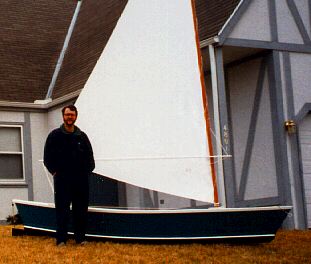
|
This lug-rigged sharpie is a very popular Bolger design since it sails well and isn't too big for one person to handle. Robert Berger's web page has some nice pix of his. |
|
|
16-ft sharpie camp cruiser with a |
|
|
I found this nice example somewhere on the Web and lost track where. Several people have since told em where. I guess I should update the caption. Long Micro is a 19-ft box-sharpie with a small keel. In this picture she's about 5 feet off the beach. |
|
|
Here's an atmospheric shot of Bill Parkes' Chebacco. This design comes in several versions (plywood chine, like this one; lapstrake; a 25-footer; and a motorsailer). Chebacco owner Bill Samson tracks the worldwide Chebacco builders' community in his web-based Chebacco News. |
|
|
Here's the motorsailer, built by Bob Cushing. Both photos are from Bill Samson's excellent Chebacco News. |
|
|
Bill Samson's paddling pirogue on the rugged coast of Scotland. Bill says: "Cop a load of this! Sheila and I had just paddled across the mile or so of open sea to the island of Lismore! Good eh? (We must have been out of our tiny minds!)" (This is not the same as the Pirogue 12 or the Common Sense Designs Sailing Pirogue. Yes, there are at least 3 Bolger Pirogues.) |
|
|
This the the Edey & Duff Dovekie.
It's a trailer-sailer camping cruiser. The mast may
look odd because the sail has been brailed up to
the mast for the night. If this were England, 1900, I suppose this would be a leeboard canoe yawl (no, there's no mizzenmast). |
|
|
An all-time classic design. Larger than the
Micro at 23', trailerable, with water ballast. The
cabin is small but spacious given its size (sounds
like a real contradiction, but sailors know exactly
what this means!) |
 |
- The plans for the Bolger Pirogue 12 are right here on
this web page. They were published in Messing About in
Boats in the June 1, 1997 issue. If you mail Bolger
$25 he'll send you two 8-1/2 x 11 sheets with the
original plan on them; it is essentially a shareware
design and he invited people to build from the plans in
MAIB.
The plan here is sufficient to build from. If you do, Phil would like you to send him $25 as a builders' fee "or 2% of the sale price" if you build one and sell it to someone.
This is not a difficult building job, but it helps to have built a "stitch & glue" boat before. If you haven't, read H. H. Payson's Build the New Instant Boats, see Chesapeake Light Craft's web site for a kitbuilding description that applies to this boat or find the Stitch & Glue Primer on Jacques Mertens' web page.
 Update:
1/1/2000
Update:
1/1/2000
- I've been paddling and sailing one for a couple of
years thanks to a loan from John Harris. I have lots of
small tips (or preferences) which should go in here -- so
expect some more soon. Any topics in italics are
things I have been too lazy to get to so far. Sorry about
that.
- In addition, John got his sails assembled (one gaff, and one lug) at a very good price from Sailrite. They no longer sell completed sails, only kits, but the price is very good (under $100 for each of these). Ask for the "Bolger Sailing Pirogue Gaff Sail" or the "CLC Mill Creek Lug Sail" depending on which one you want.

 Laying
Out the Sides
Laying
Out the Sides
Draw one side full-size on a piece of 4ft x 12ft plywood made by epoxying one and a half sheets of 1/4" plywood end to end. To mark the points which determine the sheer (the upper curve of the side) and the chine (the line where the bottom meets the sides) measure off the stations shown on the plan, and then measure off and mark two points on each station line, as shown:

Once you've done this, connect the dots with a long flexible batten (strip) of wood. A 10ft length of 1/2" PVC pipe works, too, and it's cheap. If you don't have eight hands or a couple friends to help you bend the pipe to a smooth, fair curve, drive a nail into each marked point and push the pipe or batten up against the nails with weights (bricks, books, tools, gallon jugs of water). Make sure there are no kinks in the curve, and mark along it with a magic marker or a pencil.The important part of the layout are the curves themselves. Don't worry about the actual height of the sides; the imaginary grid takes care of that. If one point or another is obviously wrong, trust the bent batten and draw the curve through wherever the batten says it should fall.
Then flip the side over and trace around it for the second side (easy!) and saw it out.
Cut out the four bulkheads: 1, 2, 3, and T. Note that transom "T" is one inch thick. It's quite small and you can probably get by with 1/2" thickness, well filleted with epoxy.
Assemble the bulkheads and sides stitch & glue fashion. Note that Bulkhead 2 is temporary and is only screwed in or glued with something like white glue or blobs of house caulk which can be scraped off (or use two vertical 1x2s joined by a slab of plywood).
Turn the assembly over and lay plywood over the bottom. Mark the outline of the sides on it. Cut out the bottom and attach it, stitch-and-glue style. John Harris added internal chine logs, or wood strips, to reinforce this joint.
Add the shoe, an extra layer of plywood down the center, outside, to stiffen the bottom and help prevent abrasion.
Then:
The gunwales.
These are strips of wood which stiffen the upper edge of the hull. They only have to extend as far as the fore and aft bulkheads. Use epoxy and clamps to attach them. Round over the inner edges to spare your flesh.
The decks.
Decks are attached in the same way that the bottom is attached. If you build solid bulkhead air tanks as John did, you do not need to glue flotation foam to the underside of the foredeck and afterdeck. I would epoxy on a 3-inch-wide backing block of 1/4-inch material across the stern (under the deck) for mounting hardware through the deck, and add an internal or external V-shaped breasthook of 1/4-inch material at the stem, extending back about four to six inches. This makes it easy to attach a nice padeye for a painter and various fairleads as required.
The rudder.
For both the rudder and leeboard, 1/2-inch is thick enough. Laminate two pieces of 1/4-in plywood under some weights against a flat surface, or find the material of your choice. Cut it out as described in the plans and fair the leading and trailing edges. See below for a bungee-scheme adapted from John Bull's book Sail Your Canoe. It pulls the rudder down while allowing it to pop up when it touches bottom. The fact that the rudder is not weighted is one of my biggest complaints about the peeros John built. John, on the other hand, doesn't mind pirouetting in place inside the boat to reset the rudder to a full down position.If you happen to have some 3/32" or 1/8" sheet aluminum running around, it can be used as the rudder. Round over the leading edge a little.
The leeboard.
Cut it out as shown. Fair, or round over, the leading and trailing edges of the leeboard. Extend the fairing on the leading edge most of the way to the centerline of the board at the top. When you're heeled over, the water can come up nearly this far. Same for the trailing edge.
The mast and rigs.
John designed a simple and effective mast step. The mast partner is a piece of wood attached to the upper side of the deck with screws from below. John decided to use some spare jibs from a racing dinghy as sails just to get them in the water during their first season:
- Jib spritsails
They work, but the mast is a little too tall for comfort in such a narrow boat! John settled on a small balanced lug, which works well.
- Balanced lugsail
Bolger has drawn a tiny gaff rig, but after experimenting I'm far from convinced that it's a very good idea. One nice thing about the peero, you can experiment with rigs like crazy without running up much of a bill. You need some tarp and a couple masts, one short and one long. For more about the sail rigs, see Odd Sails from Polytarp:
- Bolger's recommended gaff rig.
- Balanced, battened airfoil lugsail with club: Craig's experiment.
- Sharpie sail: another of Craig's experiments.
- Batwing sail: yet another experiment.
 Notes
on Small Changes
Notes
on Small Changes
Don't be afraid to personalize your pirogue with additions which you like. For example, John added rubrails on the outside and used a push-pull tiller instead of Bolger's suggested steering pedals.
- Push-pull or "Norwegian tiller" and rudder bungee with uphaul.
- Rubrails.
- Mast.
- If you decide on a gaff sail or batwing sail, make
it not 9'9", but about 10' 3" to 10'9" depending on
your height. You don't want to duck under the boom
each time you tack. It's a royal pain in the arse.
It's also nice to be able to see under the sail
without craning your neck. This is supposed to be a
relaxing little boat to sail.
- If you use the balanced lugsail, you can get by
with an 8' mast. I made one from a piece of "red cedar
baluster" which cost me about $6. It's squared with
rounded edges as it comes from the home center.
- If you decide on a gaff sail or batwing sail, make
it not 9'9", but about 10' 3" to 10'9" depending on
your height. You don't want to duck under the boom
each time you tack. It's a royal pain in the arse.
It's also nice to be able to see under the sail
without craning your neck. This is supposed to be a
relaxing little boat to sail.
- Alternative mast step.
- Bulkhead 3.
- Paddle stowage.
- Chine log.
- John put the chine logs inside the boat (a
chine log is the wood strip that forms a place
to fasten the bottom to the side) because he thinks it
looks and sails better, but you can put them on the
outside like many of Bolger's Instant Boat designs, or
just use an epoxy fillet with fiberglass tape and
forget the chine log.
- John put the chine logs inside the boat (a
chine log is the wood strip that forms a place
to fasten the bottom to the side) because he thinks it
looks and sails better, but you can put them on the
outside like many of Bolger's Instant Boat designs, or
just use an epoxy fillet with fiberglass tape and
forget the chine log.
- Scuppers.
- Handles.
- Inner Leeboard Backing Block.
- Outer Leeboard Braces.
- Leeboard Forward Position.
- Recessed Foredeck & Hatch.
- Footbraces.
- John added a pair of adjustable kayak footbraces
under the foredeck. Some sort of footbraces are
essential. These are deluxe. Yours can be simple
wooden chocks.
- John added a pair of adjustable kayak footbraces
under the foredeck. Some sort of footbraces are
essential. These are deluxe. Yours can be simple
wooden chocks.
- Craig Skeg.
- Sometimes I just felt like paddling the peero. The
rudder is annoying when you're not sailing so I came
up with a little skeg that drops over the pintles.
Much, much better: [image to come].
- Sometimes I just felt like paddling the peero. The
rudder is annoying when you're not sailing so I came
up with a little skeg that drops over the pintles.
Much, much better: [image to come].
- Seat.
- John's seat design is a stroke of pure genius: [image to come]. Imagine an oval of plywood with the narrow end cut straight across. This is the backrest, straight edge is the bottom and rests on the bottom of the boat. A reinforcement is epoxied to the back, and a line runs through the reinforcement. One side of the line is tied into a padeye (or simple hole in the gunwale) and the other passes through a jam-cleat. Just about instantly adjustable seatback position, very comfy too. Look out, La-Z-Boy!
 Notes
on Sails
Notes
on Sails
You can order the sail kits for this boat from Sailrite and the price is very good (under $100 for each of these). Ask for the "Bolger Sailing Pirogue Gaff Sail" or the "CLC Mill Creek Lug Sail" depending on which one you want.
 Thoughts
in General
Thoughts
in General
Surely I must have some. Ah yes. The best way of rigging the lugsail is found here: [URL] the system of halyards was described by George Holmes, one of the inventors of the canoe yawl, back in about 1880. It does a great job of keeping the sail taut in the luff and at the same time keeps the yard waggling to a minimum. I have some diagrams and photos which will go up ASAP.
 Pirogue
Construction Plan
Pirogue
Construction Plan
- This is scanned from Messing About in Boats. I have modified the plan only to make the dimensions clearer, clean up spurious bits of scanner crud, and fill some areas with grays to help you visualize the shapes. Click on the image to see it full size.
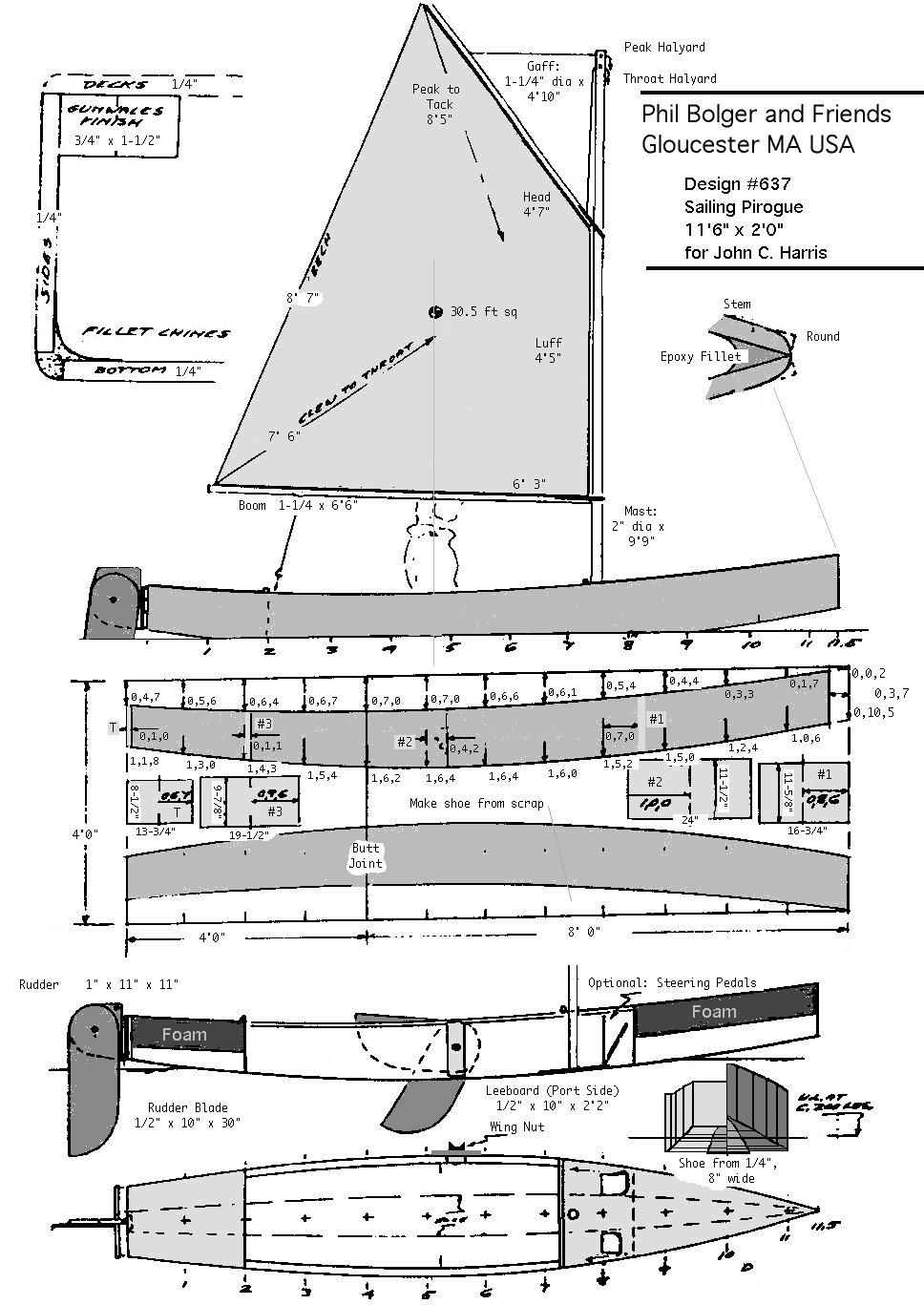
 Used
Bolger Boats
Used
Bolger Boats
I don't sell boats. I thought I might extract a few Bolger boat classified ads from Messing About in Boats from time to time. The real motivation is to convince you to subscribe to MAIB. The secondary hidden agenda is to get you on the water in a Bolger boat if you're really, really afraid to build your own.These are from September and October 1998. I can't promise that I'll update these very often, and I can't promise that I'll even keep this section here.
- Bobcat, $1,500
Sails, trailer.
Monte Rhodes, Austin TX, 512-453-4525 rhodesm@apple.com
- Gypsy, $995 with trailer
Larry Jones, Raleigh NC, 919-851-4586 larry_jones@ncsu.edu
![]() Back
to the Boats or to The
Cheap Page or to the Top.
Back
to the Boats or to The
Cheap Page or to the Top.
1.5 10/20/97 2.0 01/04/00

